STEM Activities for Pre-School Children (3-6 years)
By Dr Jennifer Martay, PE
Course Leader for Medical Engineering at Anglia Ruskin University
I am a Biomedical Engineer with 3 young children. This page suggests games, kits, and activities to teach STEM skills to pre-school children (3-6 years). I also made the YouTube video below talking about our favorite STEM activities in this age range. Feel free to leave comments below the video.
S: Science
At this age, Science focuses on learning the basics of Biology, Chemistry, and Physics. These activities
can be done at home with items you likely already have.
-Biology: Plants. Plant/grow different flowers, vegetables, or fruits in yard OR look
at plants in park. Identify seed, roots, stem, leaves, petals on plants. Make and label picture.
Pros: Kids generally like and are proud of growing plants (and teaches patience and responsibility of watering as well!).
Drawing can be done on rainy days and is a nice keepsake. Also give practice writing and spelling. Low cost.
Cons: Kids may be disappointed if plant doesn't grow. Planting can be muddy activity.
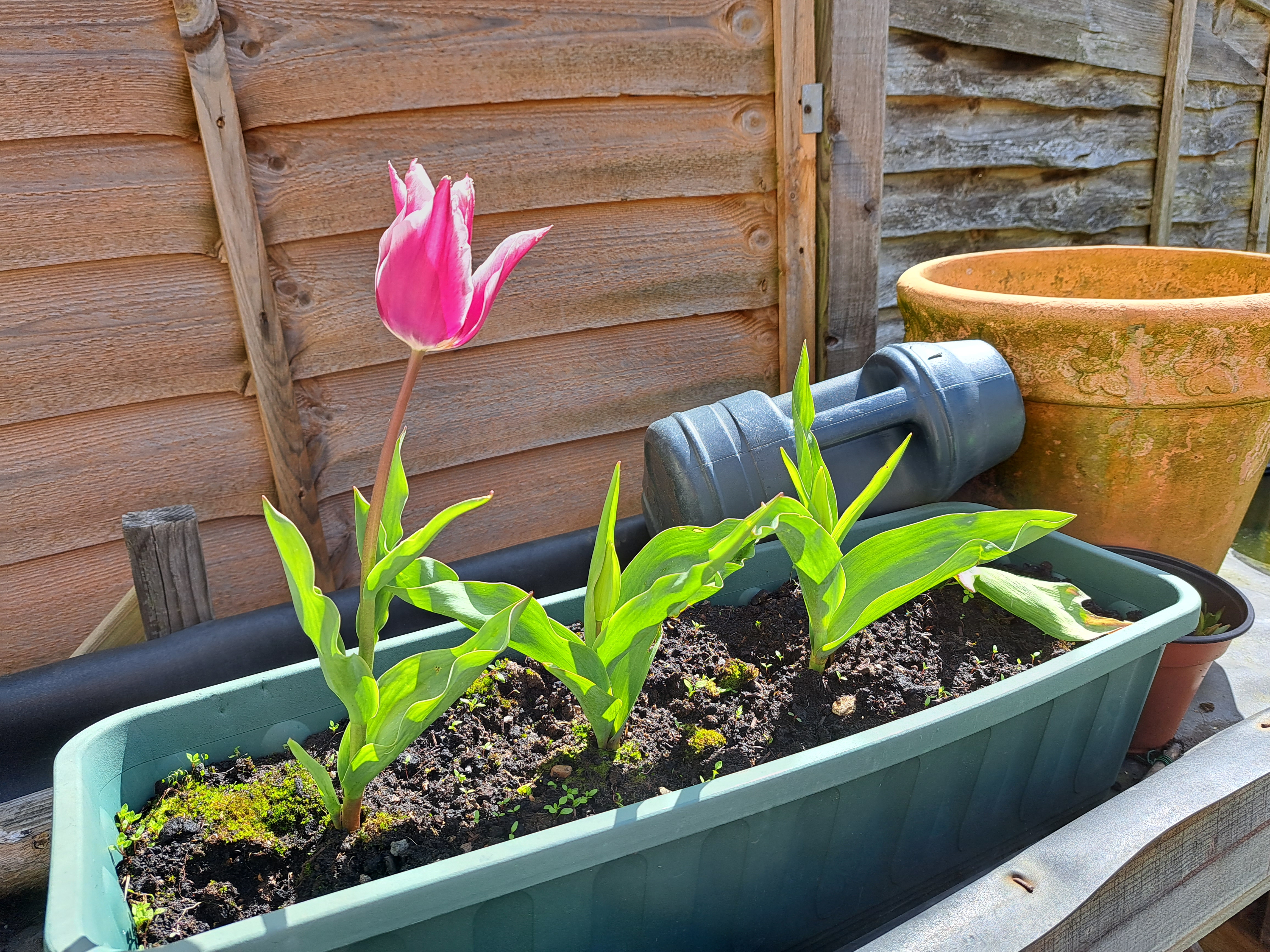
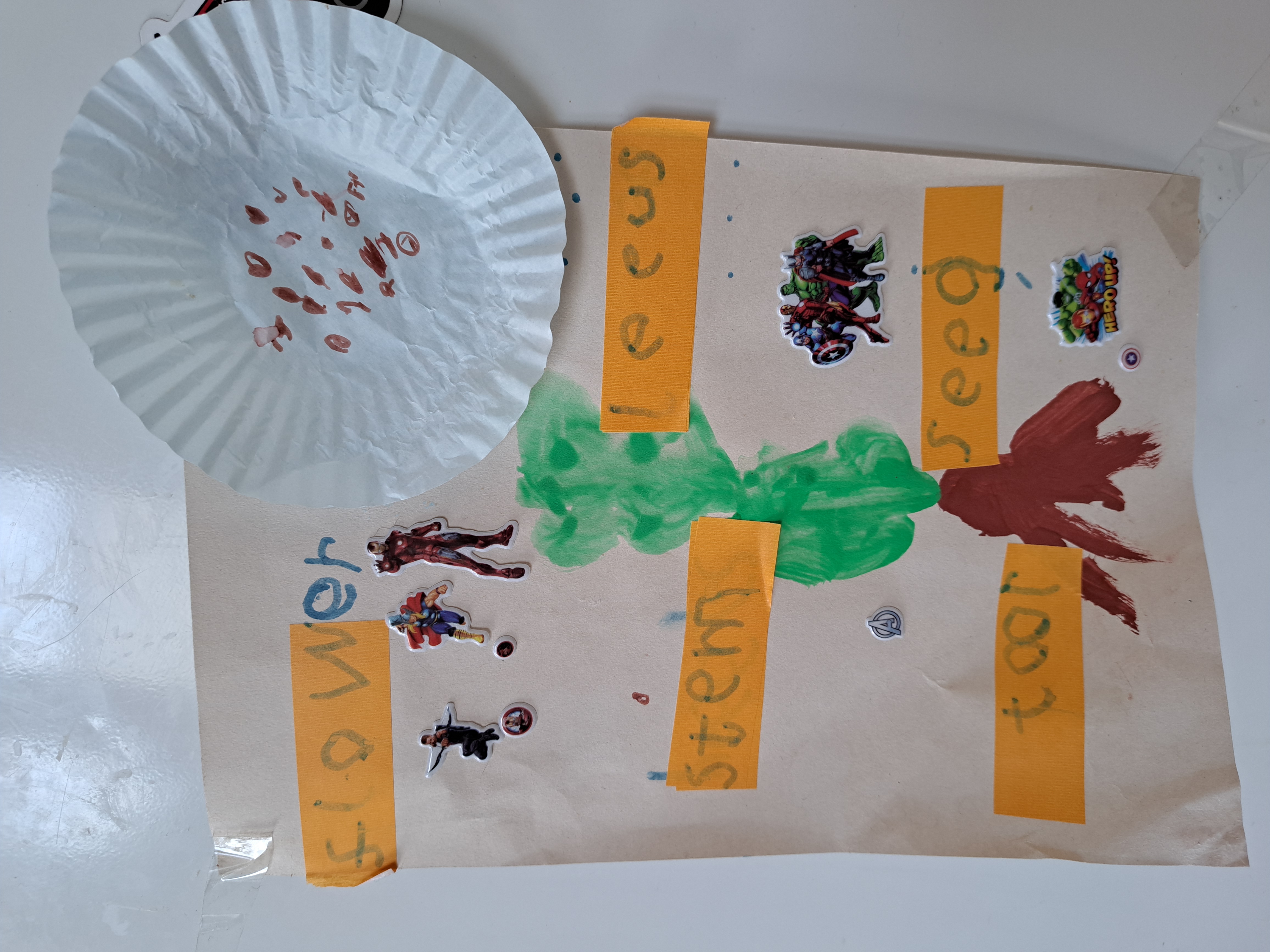
-Chemistry: Acids and Bases. Use red cabbage juice to test whether household items are acidic (turns red) or
alkaline/basic (turns blue).
Pros: Allows kids the freedom and creativity to select items they want to test. Fun to watch cabbage juice change color.
Cons: Can get messy. Need to buy red cabbage if don't already have it. Short activity with some prep and clean-up required.
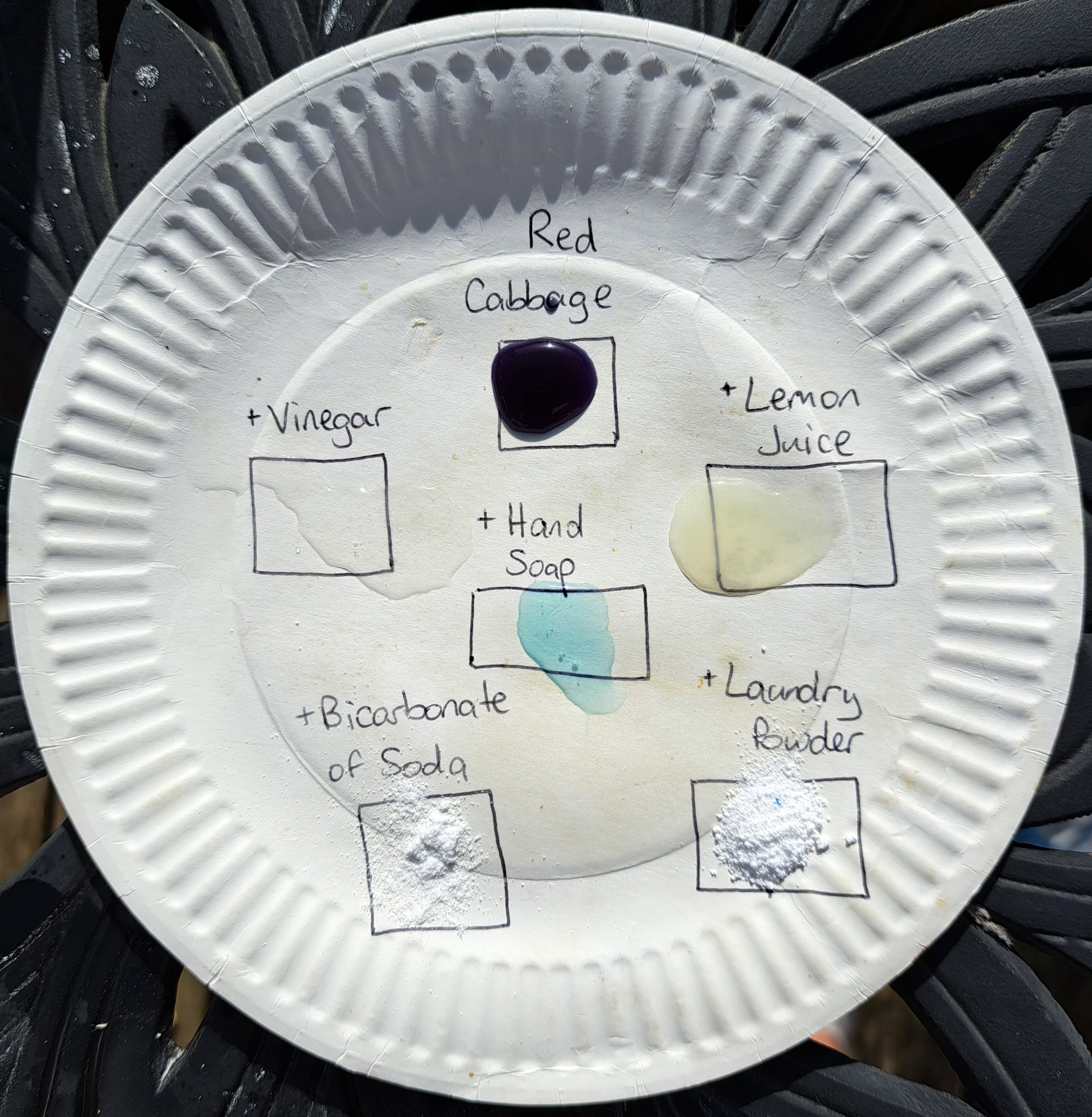
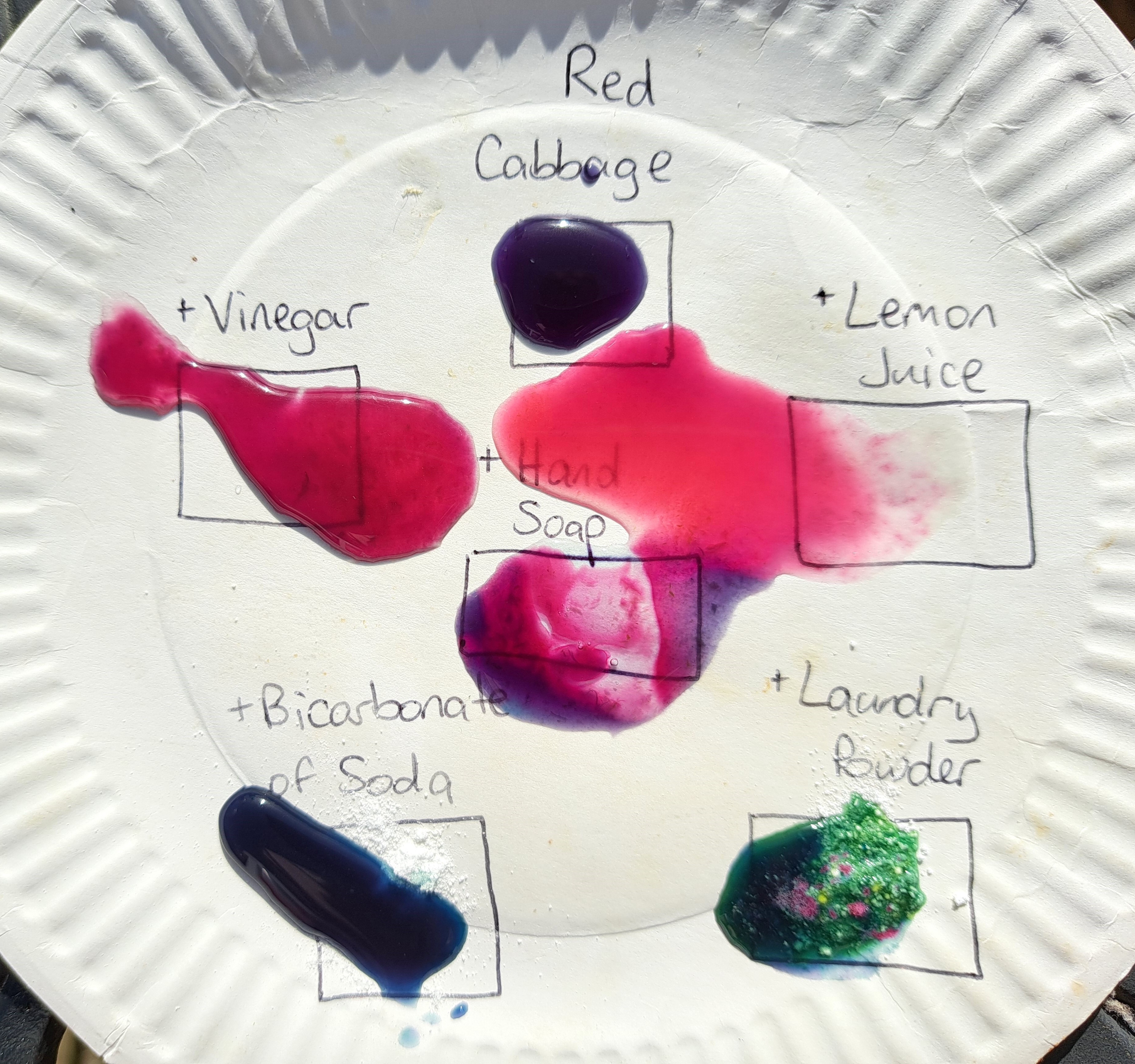
-Physics: Bouyency. Guess which household items will sink or float in water - then test it out!
Pros: Kids love playing in water! Allows kids to guess and test their own theories. No associated cost.
Cons: Adult supervision required around water - to make sure it doesn't spill and only things that can go into water do!
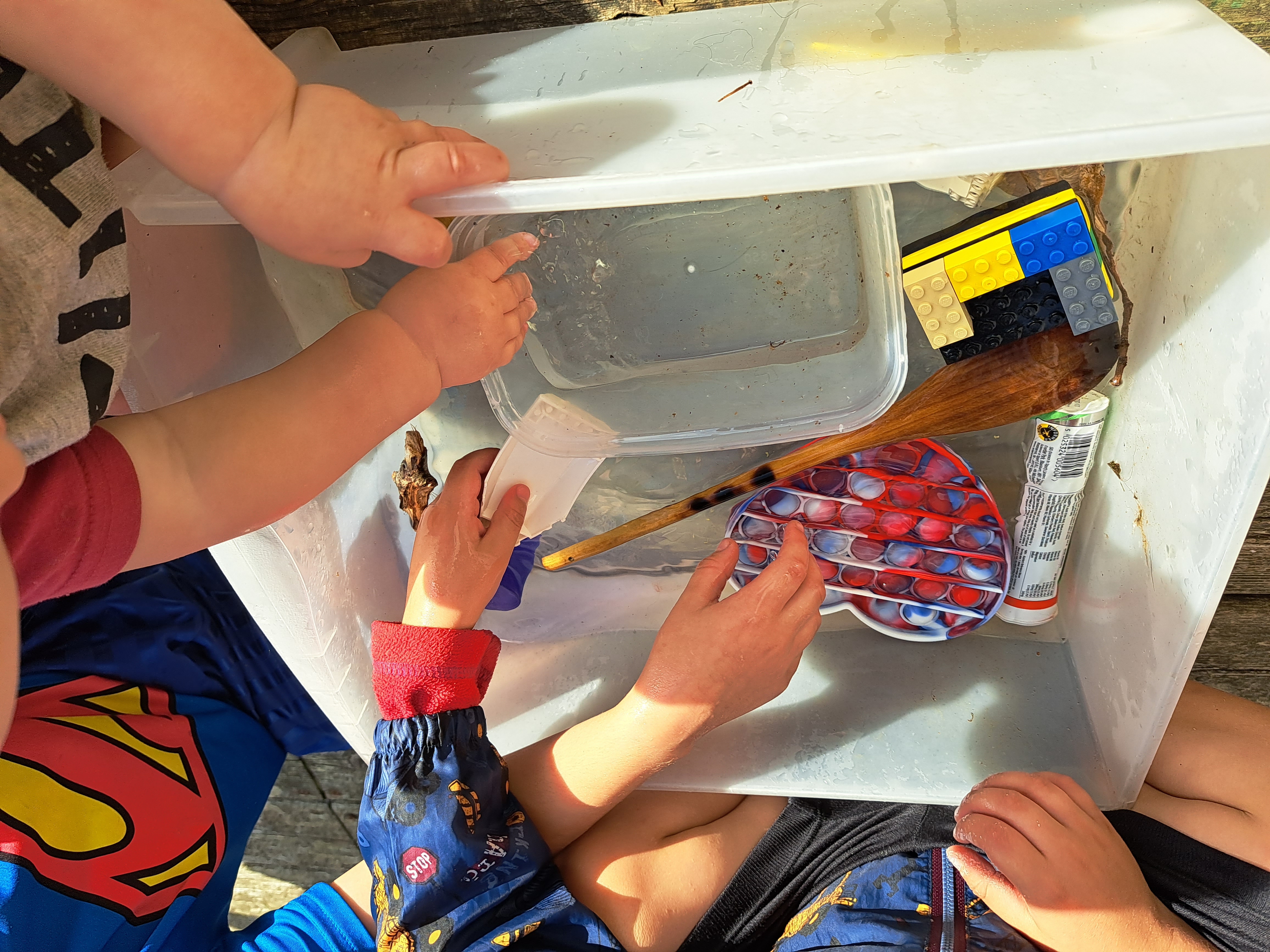
-Environmental Science: Recycling. Discuss which everyday items can be recycled, recycling processes, and what
new items the recycled materials can make. Say hello to weekly recycling truck crew. Visit local Recycling Centre if possible.
Pros: Important and frequently overlooked topic. Kids love understanding how and why things happen, especially watching
the weekly recycling truck or visiting a loud, full-of-life recycling centre.
Cons: Potential sensory overload of sounds and smells.

-Visit London Science Museum (or local Science Museum). Learn about science through hands-on, interactive exhibits.
Pros: Huge variety of topics to explore. Can attend multiple times and still learn new things. Exhibits usually very
engaging. Generally free admission.
Cons: Need to travel to museum. May have limited opening hours.

Picture By Shadowssettle - Own work, CC BY-SA 4.0, https://commons.wikimedia.org/w/index.php?curid=94997583
T: Technology
At this age, Technology focuses on fine motor skills and a broad familiarity of the different types of technology used in
society. These activities can be free using items already available in
the home or can include games easily and cheaply available second-hand from charity shops.
-Shadow Drawing. Practice motor skills while drawing animals' shadows onto a piece of paper.
Pros: Kids choose animals to draw. Nice keepsake. No associated cost.
Cons: Need sunny day (or use own light).
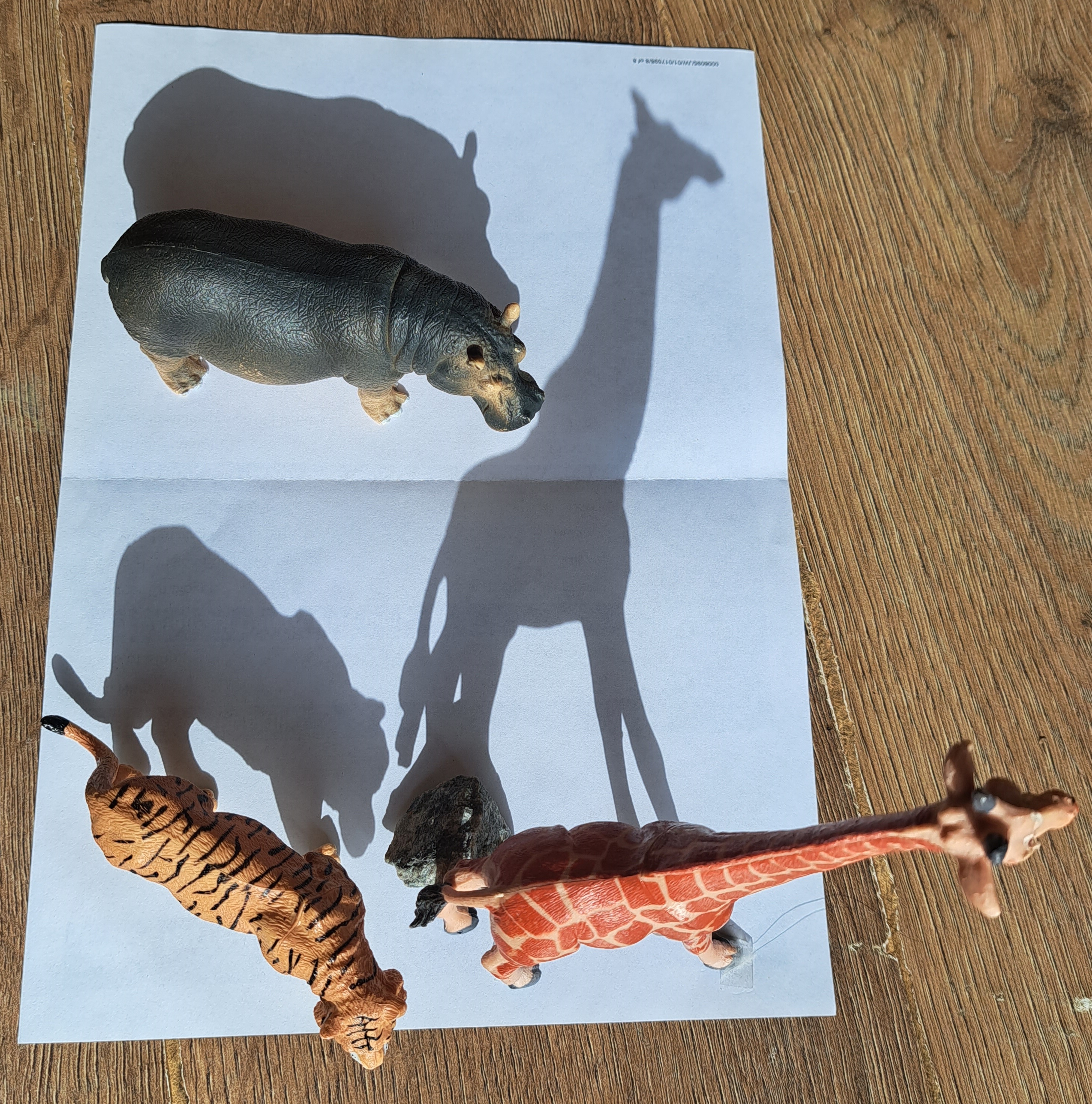
-"Rockin' Robot" from ELC (Early Learning Centre).
Players: 1+
Recommended ages: 2-5 years
Time to play: 5+ minutes
Paid: £1 from charity shop
Build the robot shown on the card (there are 20 cards, each with different colours/patterns) before the timer pops
the pieces off (up to 60 seconds).
Pros: No set-up required: just pick a card, wind up the timer, and build. Clean up is putting pieces back in box.
Easy for even young children to understand and play. Can adjust timer to require faster building skills.
Colourful, robust pieces. Good re-playability. No help required from parents.
Cons: Likely boring for children over 5+ years. Pop'ing sound may startle children. Pop'ing pieces may hit
children (unlikely to injure unless hit eyes).
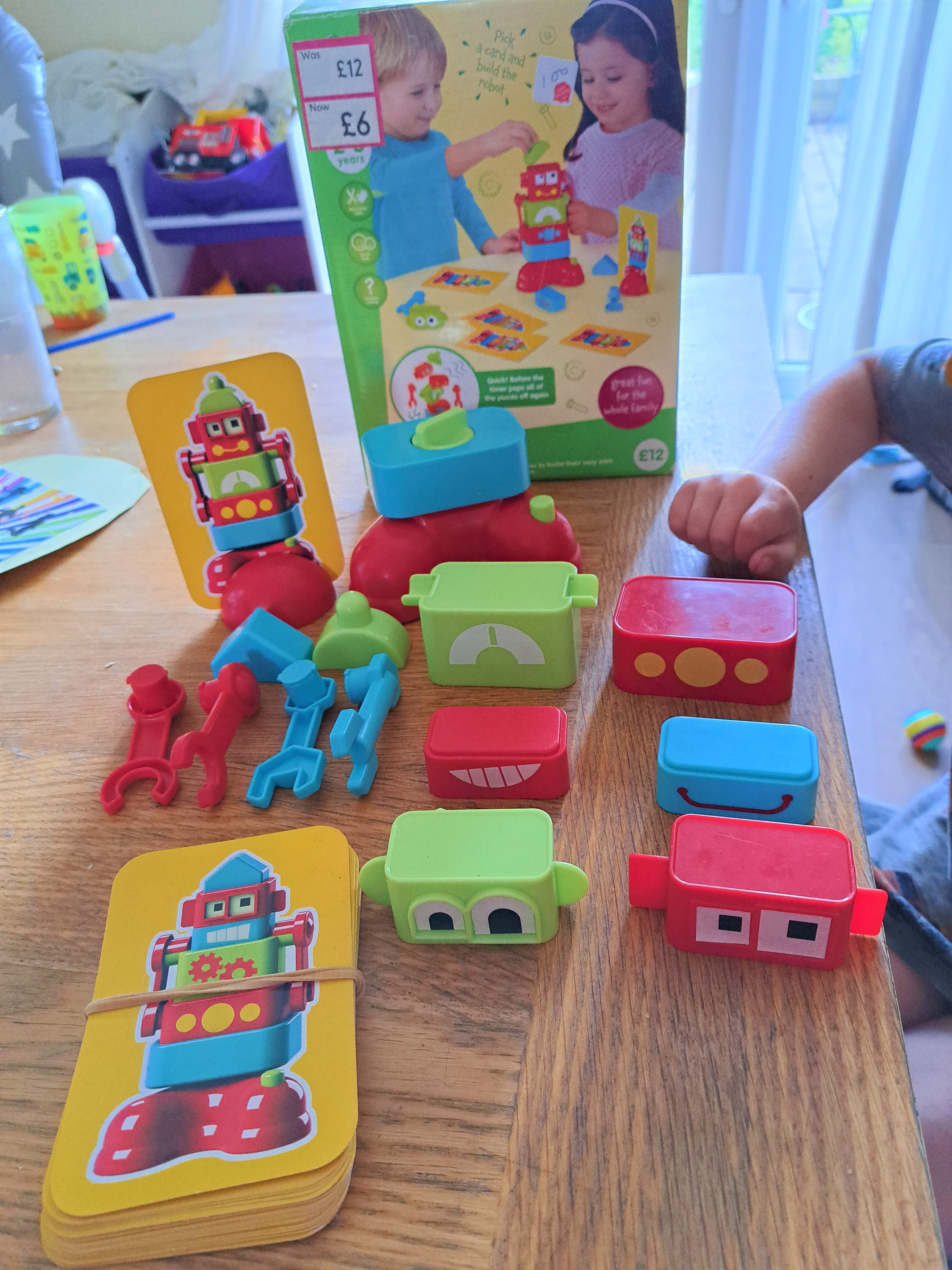
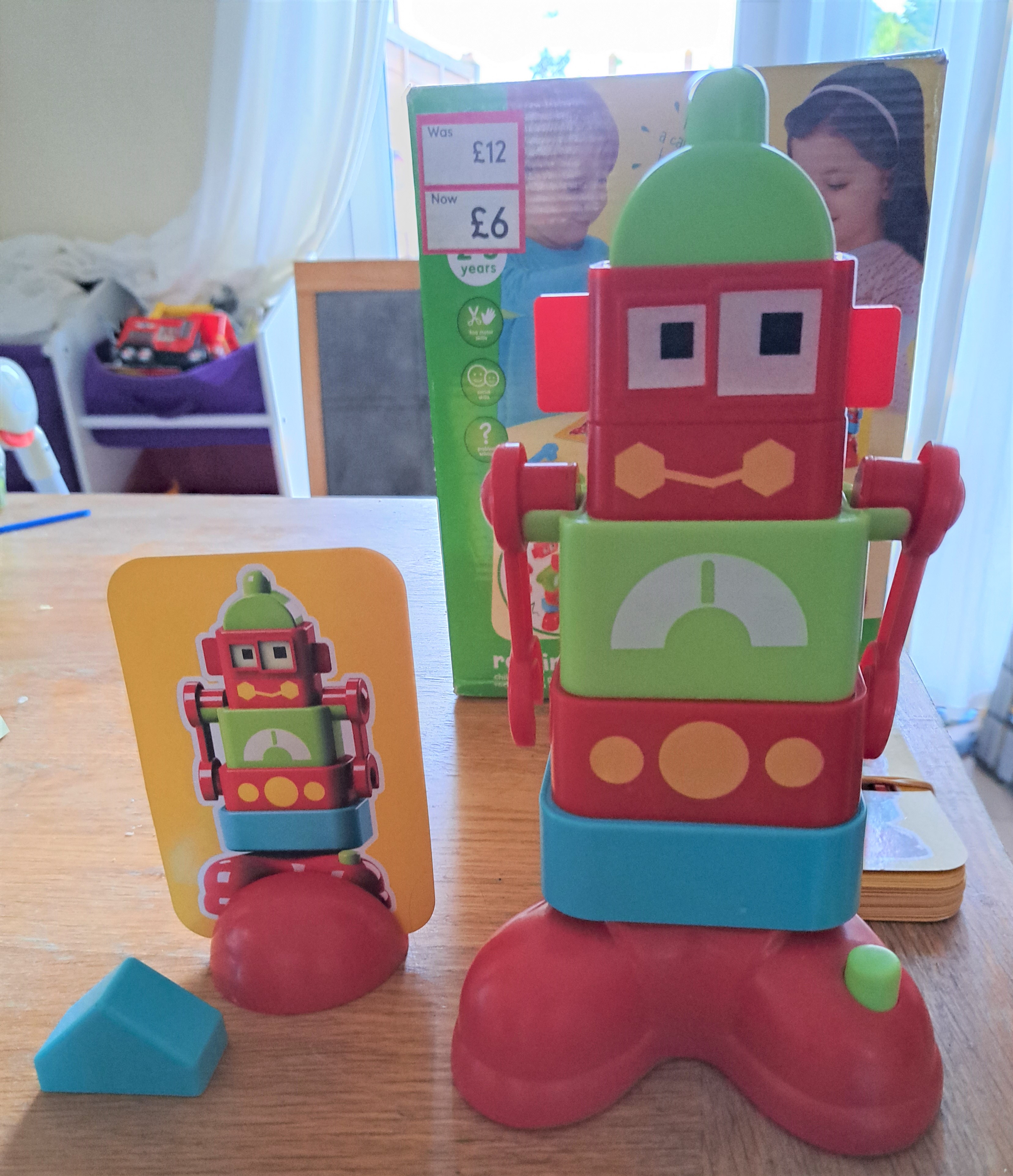
-
"Operation" from Milton Bradley/Hasbro.
Players: 1+
Recommended ages: 6+ years
Time to play: 10+ minutes
Paid: £1 from charity shop
Practice hand-eye coordination and fine motor skills by using tweezers to remove items from inside Sam - but don't touch the
edges!
Pros: Very little set-up or clean-up: just putting pieces in and putting them into place. Easy to understand. No help
required from parents. Fun theme. Good replayability.
Cons: Smaller pieces which can be lost or swallowed. May require battery.
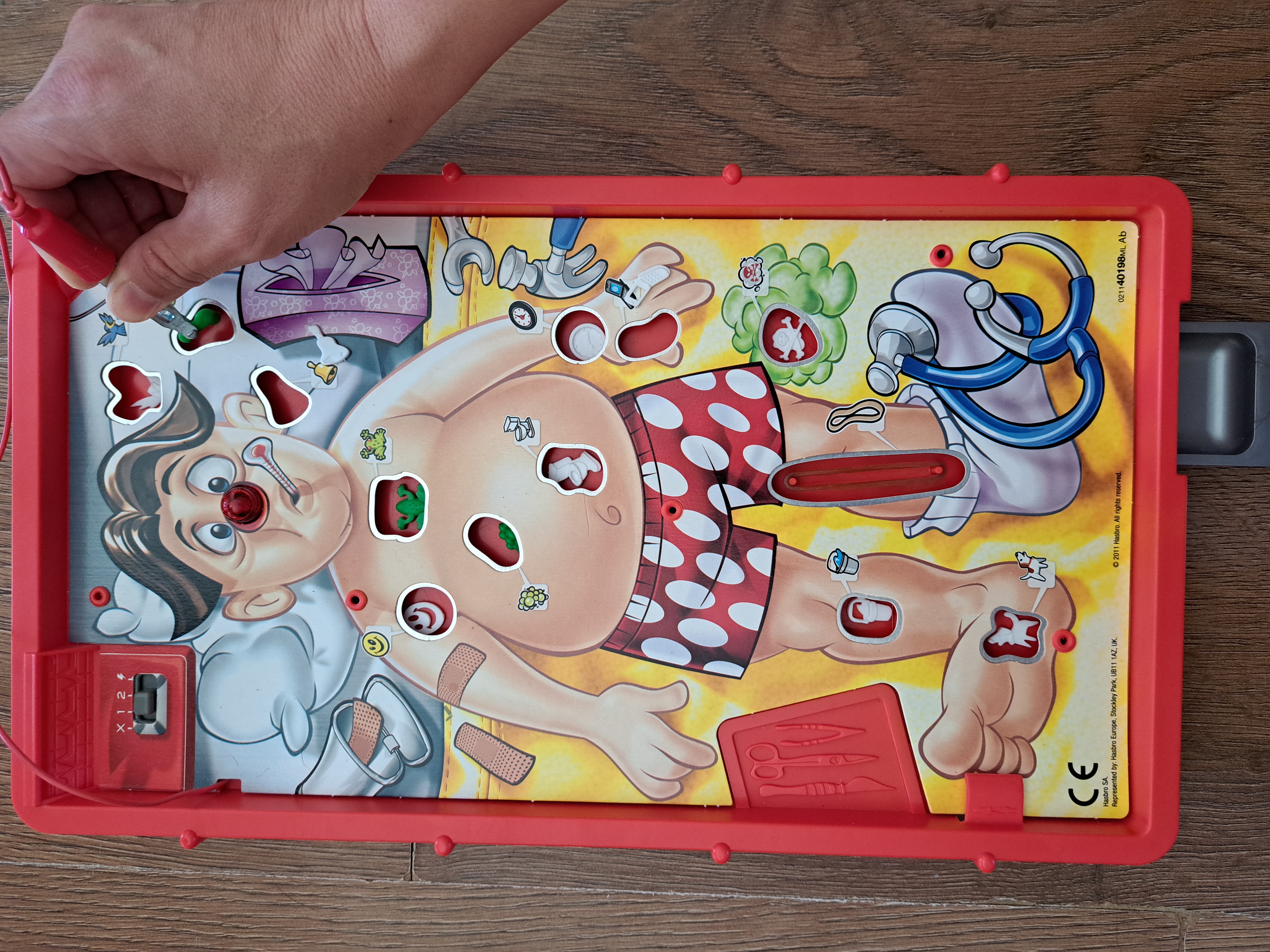
-Arts & Crafts. Make people, animals, vehicles, etc from household items such as cardboard rolls, tin cans, and
plastic bottles.
Pros: Allows kids to be creative and inventive. Nice keepsake (see below). No associated cost.
Cons: Adult supervision required for cutting or sharp edges. Kids and adults may disagree about whether to keep the creation!
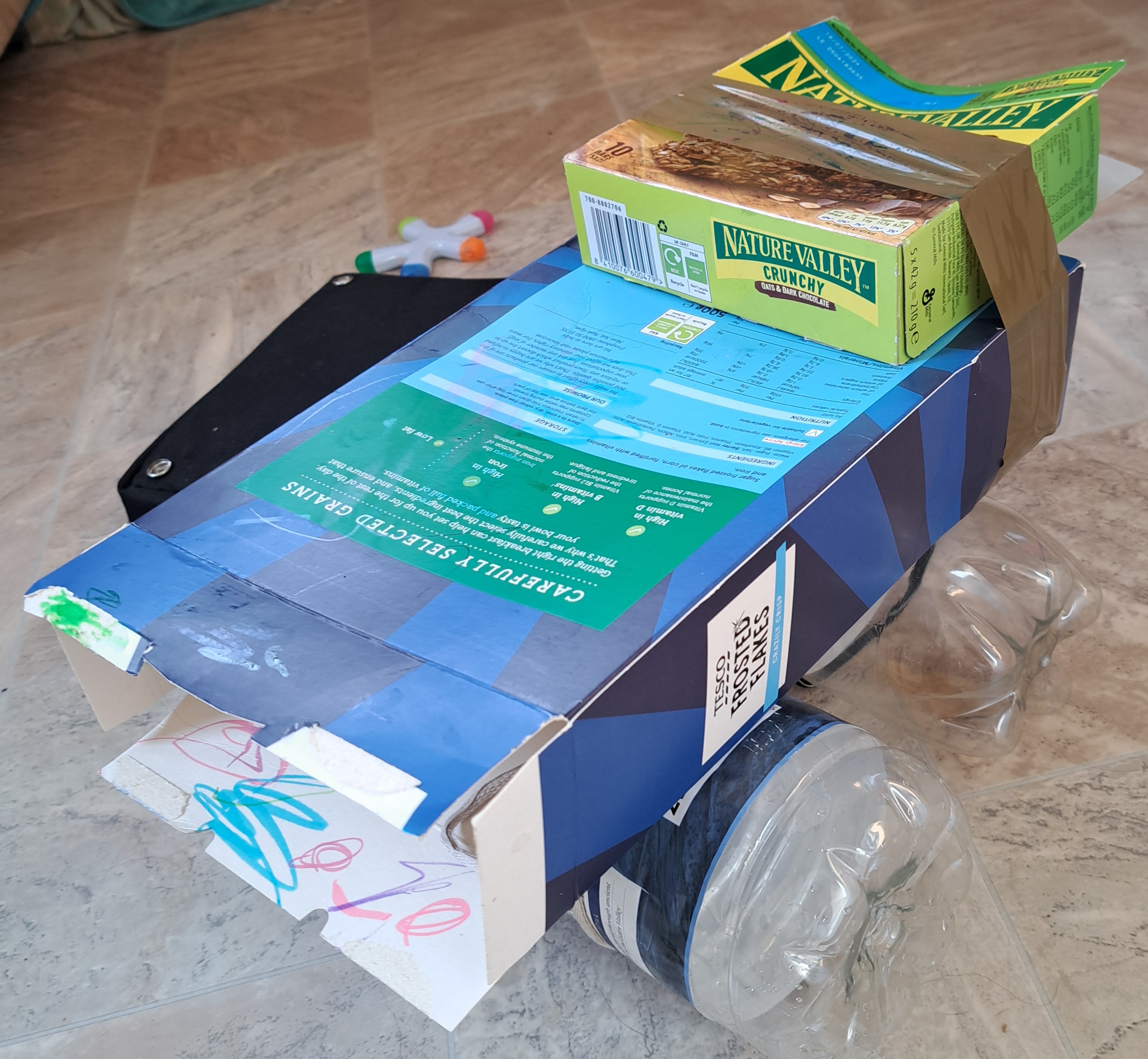
-Tool Making. Make tools out of household items, for example making fishing rod out of branch or dowel.
Pros: Allows kids to be creative and inventive. Nice keepsake (see below). No associated cost.
Cons: Adult supervision required for cutting or sharp edges. Kids and adults may disagree about whether to keep the creation!
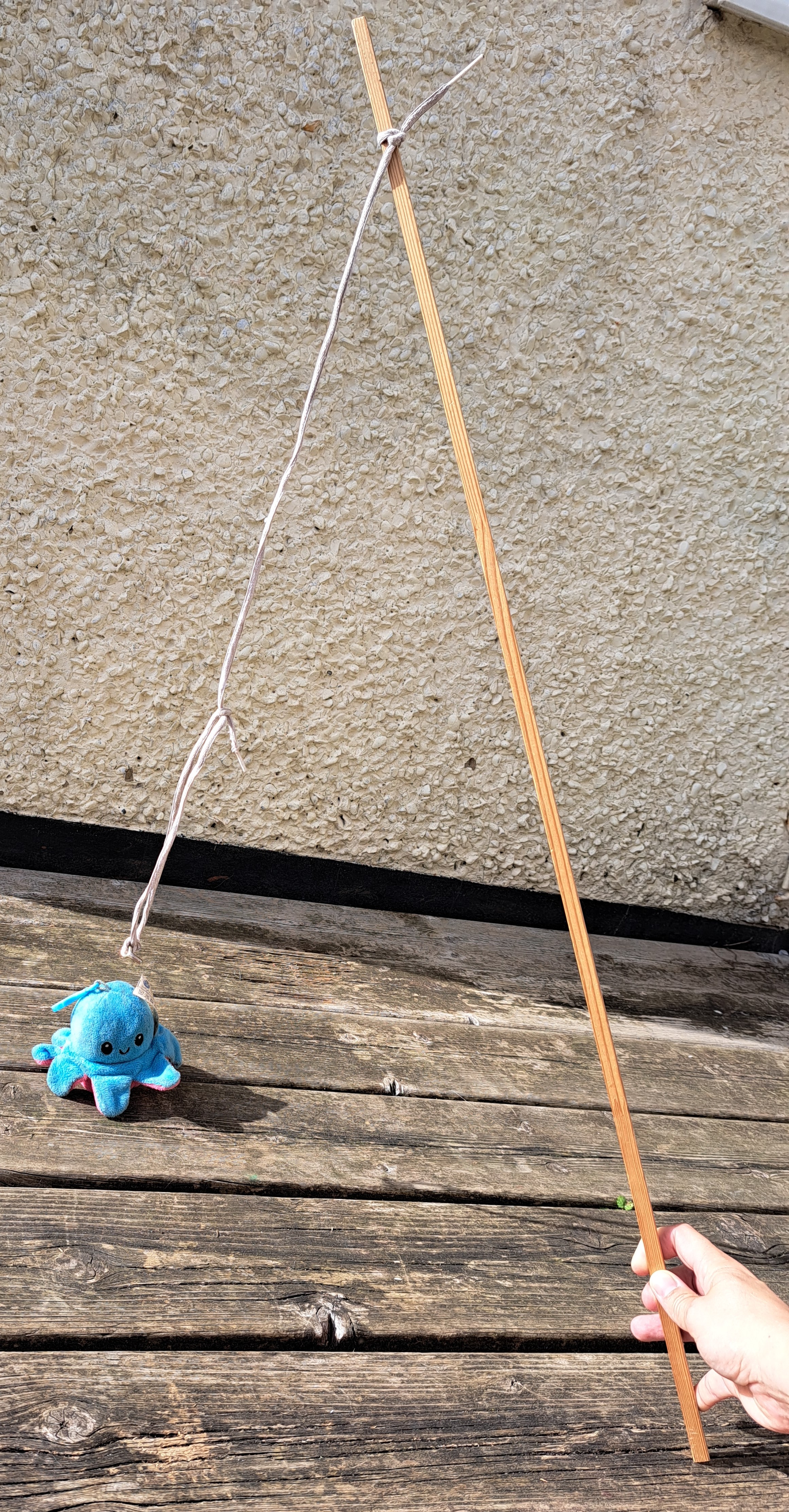
-Grace's Amazing Machines: TV Show from BBC. Kids TV show about all different kinds of machines. There are 80 episodes,
each with 3 machines. Definite favorite in our house! Follow-on from "Catie's Amazing Machines" (20 more episodes).
Pros: Huge variety of machines (frequently fast, exciting vehicles) introduced. Fun for both kids and adults to watch.
Cons: I suggest trying to limit kids' screentime. Need BBC subscription to watch.
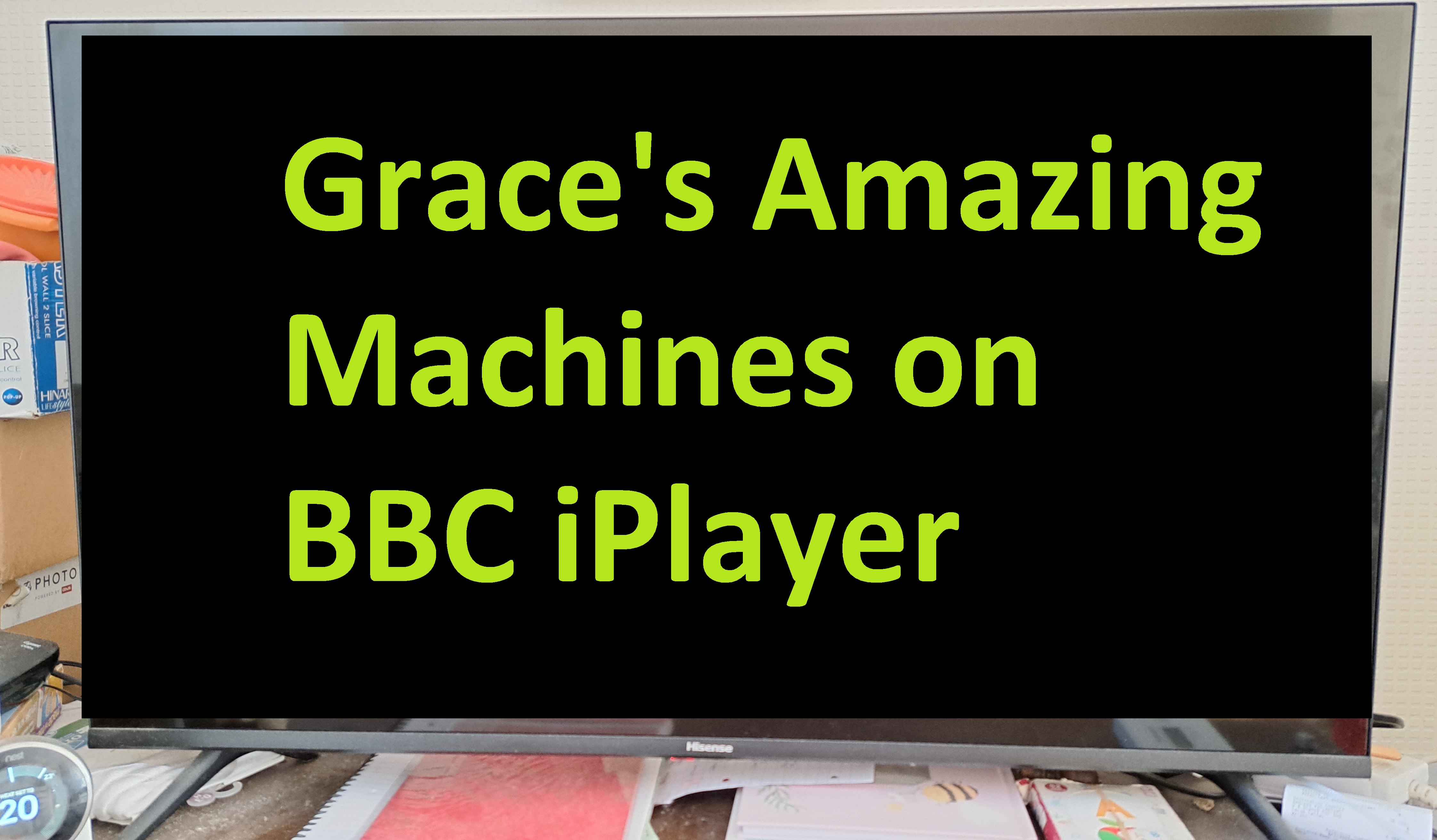
E: Engineering
At this age, Engineering focuses on problem solving and creatively building structures and mechanisms. These activities
can involve store-bought items or can use common household items.
-
"Marble Run" from Smyths Toy Store (widely available from other retailers or second-hand).
Players: 1+
Recommended ages: 4+ years
Time to play: 10+ minutes
Paid: £15 from toy shop
Use your creativity to construct your own contraption. Then watch your marbles go through spinners, chutes, drops, ramps,
and a vortex. A favorite in our house (until it had to be put away because of the baby)! For added challenge, make runs
that meet specific criteria, such as "run time of 11 seconds",
"tallest contraption", or "using all components". You can also build a homemade marble run using cardboard boxes,
paper cups, and other household items. Making a homemade marble run builds gross and fine motor skills as well.
Pros: Fosters creativity and understanding of mechanisms. Excellent replayability. Easy for children to understand and
play without adult supervision. Also fun for adults!
Cons: Marbles can be lost and are choking hazards for small children. So many pieces that it is easy to lose some without
noticing. Adult supervision recommended if making your own marble run.
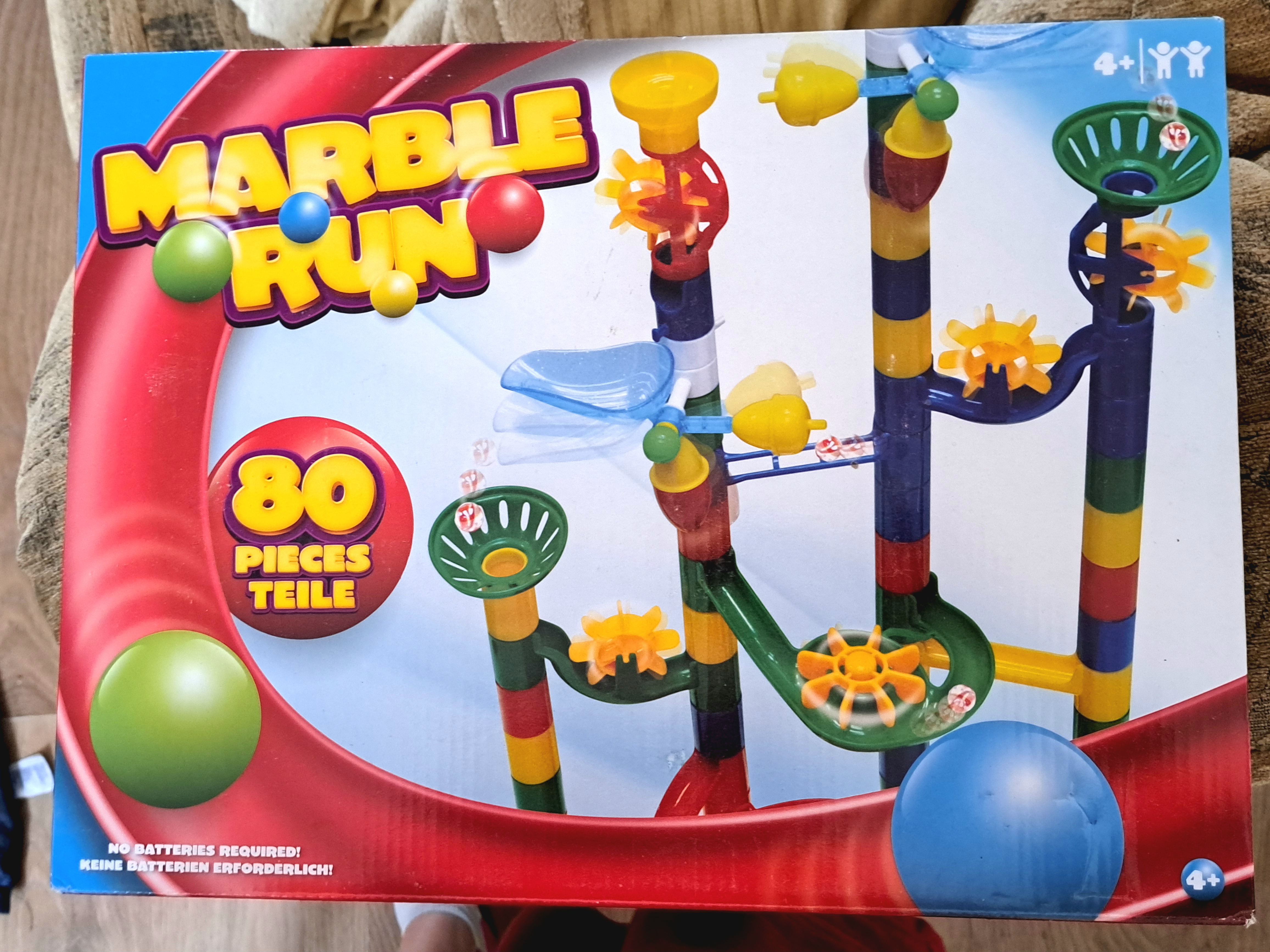
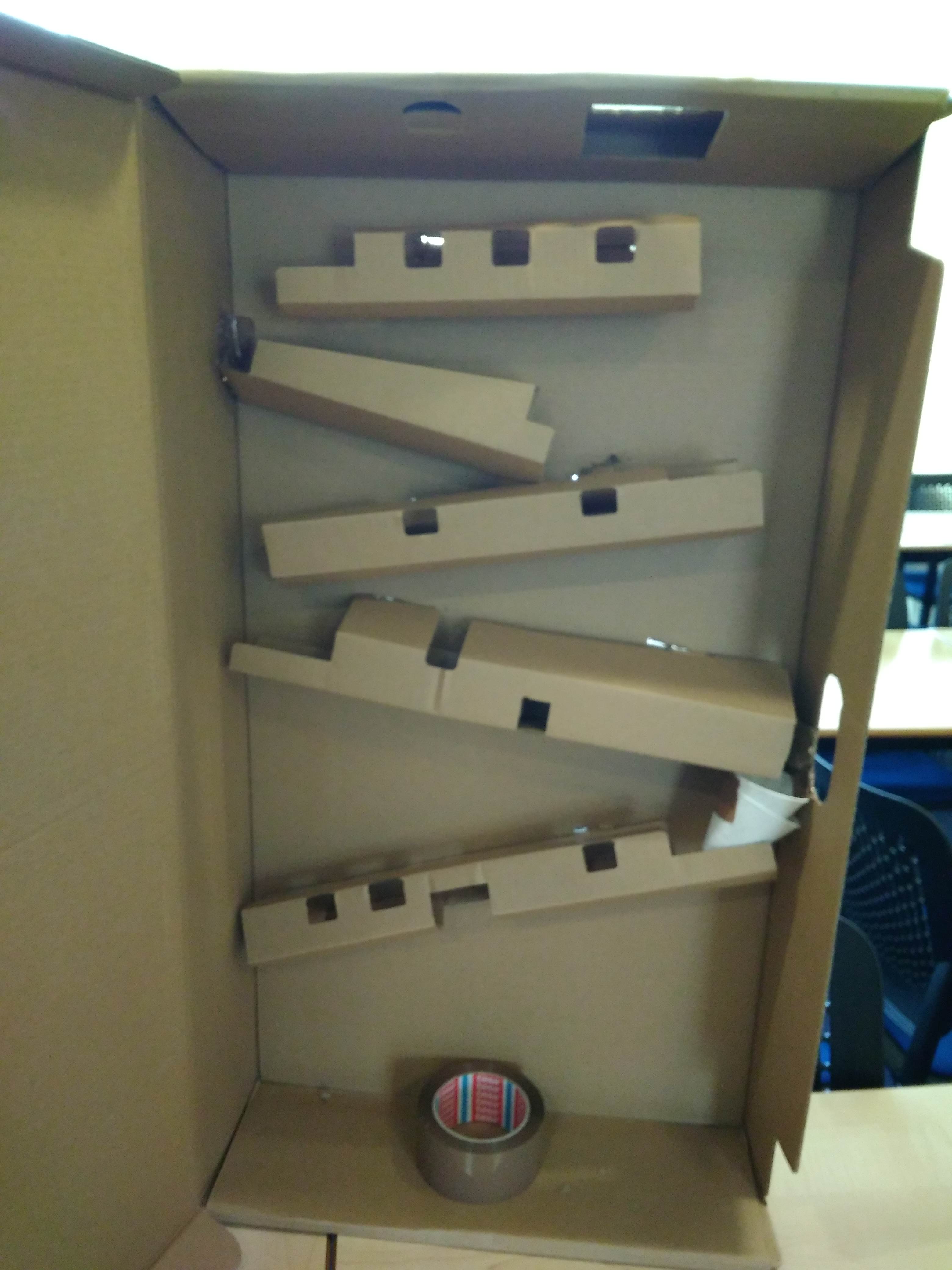
-
"Build-Your-Own Den" from The Works (also available from other retailers or sometimes second-hand).
Players: 1+
Recommended ages: 5+ years
Time to play: 20+ minutes
Paid: £12 from toy shop
Use provided balls and sticks to build various structures. Can cover structure with light blanket to make more realistic
fort. If you don't want to buy the kit, you can also make a fort using chairs/sofas and blankets - or combine chairs, sofas,
and blankets with kit to make even bigger fort!
Pros: Many types of forts can be built, with some creativity (see below). Teaches about frames and how to create stable
structure. Kids really liked it (for a while).
Cons: Technically, many types of forts can be built, but realistically, there are only a few configurations you are likely to
make. Limited replayability with just the kit (kids quickly got bored). Sticks break if stepped on. Sticks were difficult to stick
into balls in one kit (but easy in the other?). Many pieces to clean up. Structures fairly flimsy and could only support
lightweight blanket. Needed adult supervision and help to build.
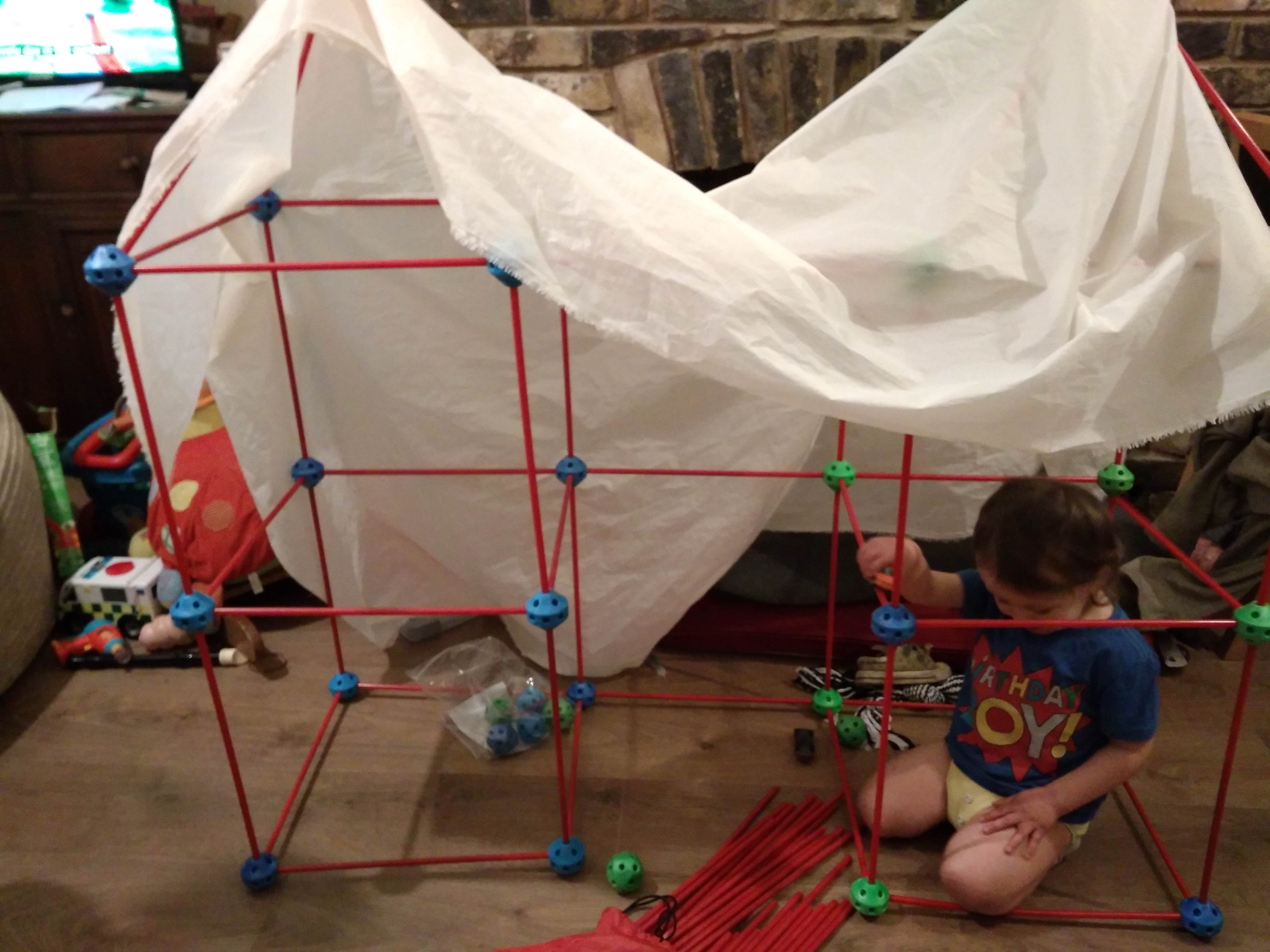
-Lego Pieces and Kits, widely available from multiple retailers or second-hand.
Players: 1+
Recommended ages: 4+ years
Time to play: 10+ minutes
Paid: Price varies from cheap second-hand to extremely expensive for larger franchised kits
A world of options to build and re-build whatever you want! Can also buy kits to build pre-determined
creations. We tend to prefer not building to a kit.
Pros: Literally limitless options of potential building projects. Fosters creativity and motor skills. Building to a kit
can teach kids to follow instruction manuals. Kids generally very proud of creations.
Cons: Can be very expensive for kits - and if using a kit, can be easy to lose a vital piece which is hard to replace. Pieces
easy to lose and step on. Small pieces can be choking hazards.

-
"Outfoxed!" by Gamewright.
Players: 2-4
Recommended ages: 5+ years
Time to play: 20+ minutes
Paid: ~£20 from Amazon
This is a Cooperative Deductive Reasoning Game. I have included the game in this list because Logical Thinking is an
Engineering STEM skill. In this game, players work together to figure out which of the Suspects has stolen a pie. Players
figure this out using clues, which show what the thief was or was not wearing. Players then eliminate Suspects based on these
clues until only one Suspect remains. But players have to be quick or the Fox will escape! This was the first board game
my kids liked - and it's still a favorite nearly a year later!
Pros: Cooperative game so no single loser or winner. Game is easy to understand and play. Kids like they get to choose what
to do on turn and where to move character. Fun theme for kids and adults. Good for practicing deductive reasoning,
counting paw prints oon dice, counting spaces moved, taking turns.
Cons: Unlikely to find second-hand so will cost around £20. Game unplayable if lose any of the cards. Need multiple
players. Dice and player hats could be choking hazards for younger kids.
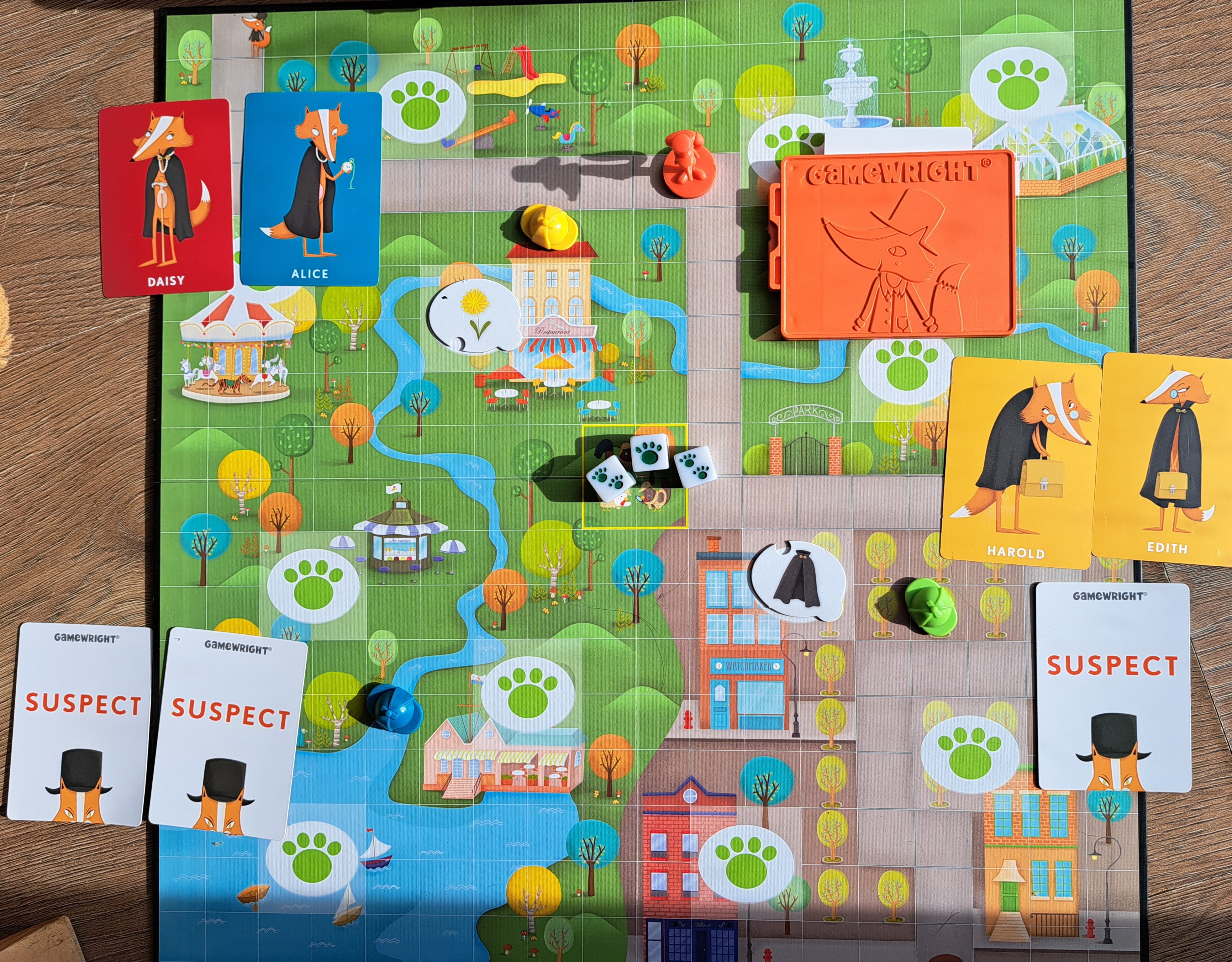
-Blaze and The Monster Machines: TV Show on Amazon Prime. Animated kids TV show about monster trucks. In each episode,
the monster trucks talk about and use a different STEM concept (for example, acceleration, momentum, friction, tensile
strength) to overcome obstacles/traps set by other monster trucks. More than 100 episodes currently available.
Pros: Fun for both kids and adults to watch. Kids learn STEM concepts without realizing it. Many episodes available.
Cons: I suggest trying to limit kids' screentime. Need Amazon Prime subscription to watch (some series aren't free to watch).

M: Mathematics
At this age, Mathematics focuses on a firm understanding of numbers up to 10, counting to 30, and very simple addition
and subtraction.
-Counting Everyday Objects. Aim to recognize, count, and write numbers to 10 by around 5 years old - and to 30 by around
6 years old. Practice recognizing, counting, and writing the numbers of everyday objects during daily-life (find numbers
on street signs, house fronts, food packages, TV shows, books, prices, etc).
Pros: No associated cost. Can be done quickly while playing or in everyday life, with no additional set-up or clean-up.
Cons: None.
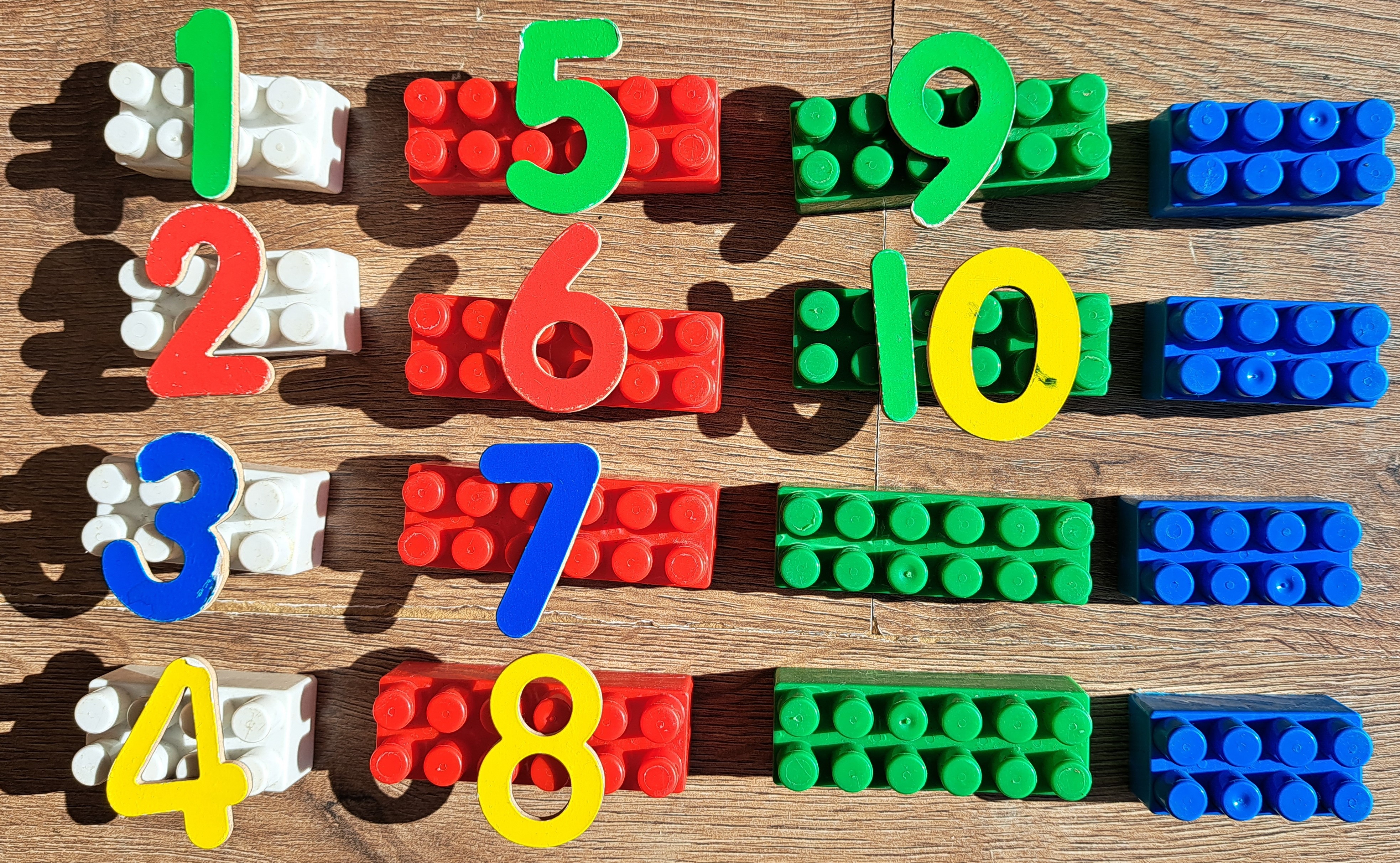
-
"Monkey Balance Math Game" by No Company Listed! Many companies sell similar things.
Players: 1-4
Recommended ages: 5+ years
Time to play: 15+ minutes
Paid: 50p from charity shop
Practice counting and basic addition by balancing monkeys and numbers (each number weighs its multiple of 1 - so "6" weighs
twice as much as "3" for example) on a scale.
Pros: Game difficulty can be increased as kid's understanding of numbers grows. Can start by balancing 1 monkey with 1 monkey,
then move onto balancing 1 monkey with the number 1, then finally do the addition cards. Easy for kids to understand and play.
No adult supervision required.
Cons: Easy to lose monkeys (although extras are included). Monkeys can be choking hazard for smaller children. Scale breaks
if kids put too much weight on them.
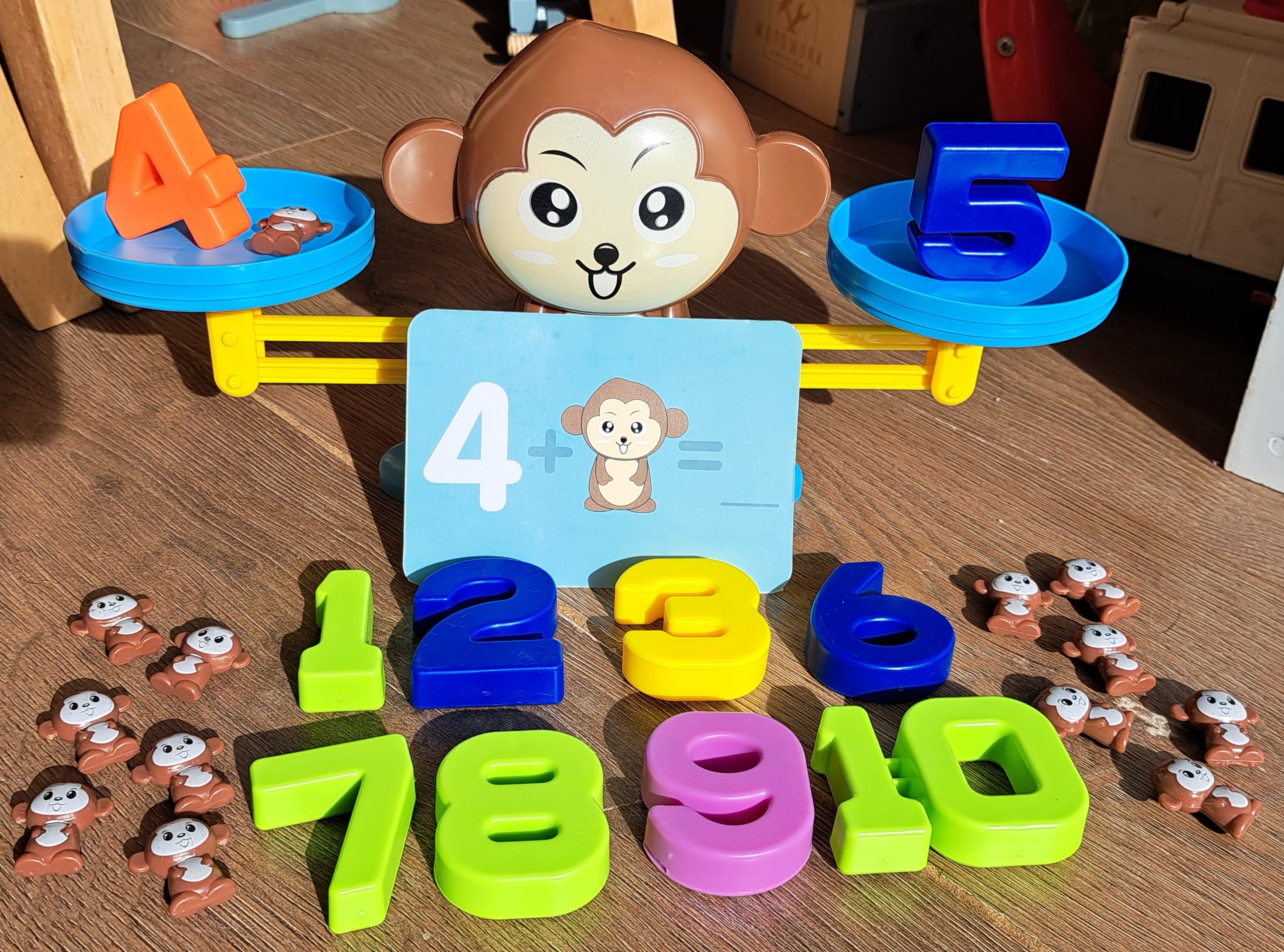
-"Sum Swamp" by Learning Resources.
Players: 2-4
Recommended ages: 5+ years
Time to play: 20+ minutes
Paid: £3 from second-hand sale
Use basic addition and subtraction and knowledge of odd vs even numbers to be the first to cross the swamp. In each turn,
you roll 3 dice: 2 have numbers 1-6, the third dice has + and - signs to say whether you add or subtract the numbers on the
other 2 dice. Then you move forward that number.
Pros: Easy for kids to understand and play, although it's good to have an adult nearby to verify answers are correct. Kids
like the swamp theme and chosing their character. Limited set-up and clean-up. Good introduction to board games.
Cons: Be careful not to lose the +/- dice as it'd be hard to replace! This game may be boring for 5 year old kids (our 4 year old
really likes it, the 5 year old finds it too simple).
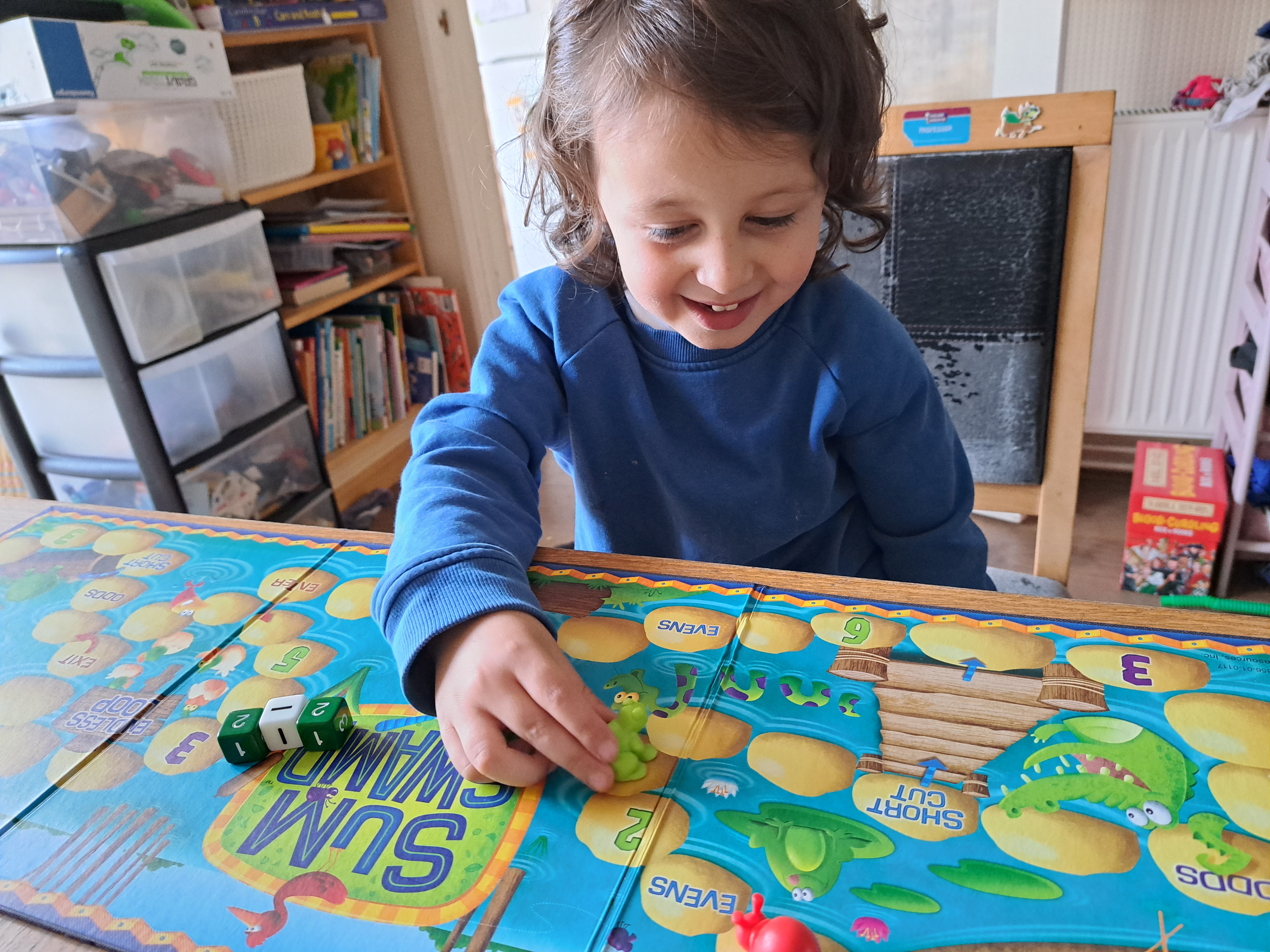
-Numberblocks: TV Show from BBC. Animated kids TV show. Early episodes focus on numbers 1-5. Middle episodes focus on
numbers up to 100. Later episodes focus on odd vs even numbers and multiplication.
Pros: Catchy songs and cute animations make show fun for both kids and adults. Kids learning numbers in a fun environment.
Cons: I suggest trying to limit kids' screentime. Need BBC subscription to watch.
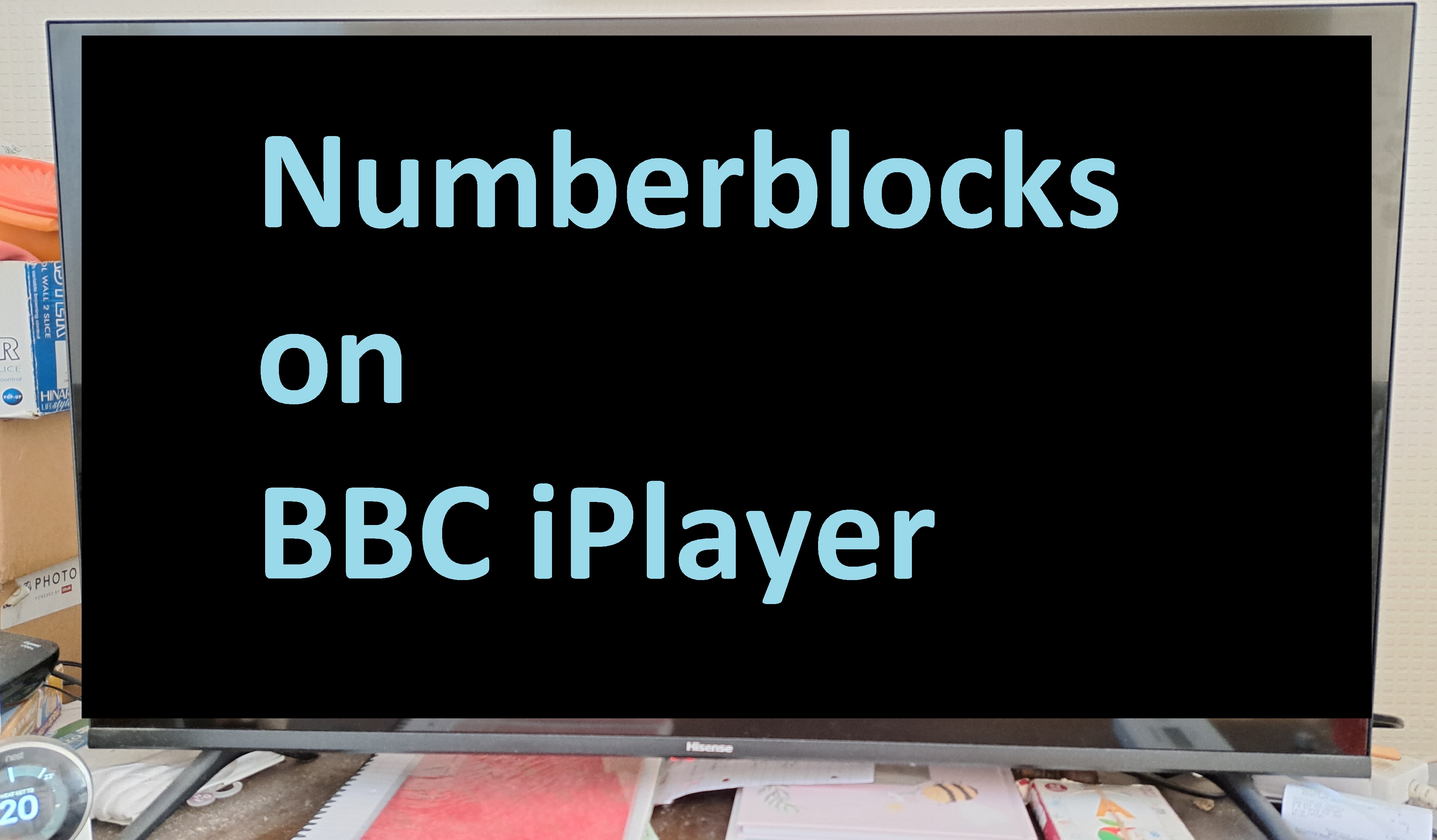
This website was created in October 2023 based on what was available at the time and what my children have enjoyed. There will doubtless be other games and activities you have also enjoyed. Please leave comments below the YouTube video if you have other activities you suggest adding to the list. Thank you for reading!
Other Articles:
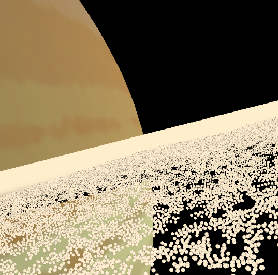
|
Saturn's ringsA simulation of Saturn's rings --- a few thousand particles are simulated, in a repeating tiled region. You use the mouse and keys to fly in it. |

|
Atomistic Simulation of MetalsThis presents an interactive simulation of atoms making up a nanoscopic particle of metal. |

|
Chernobyl SimulationAn attempt to simulate the normal running, and then accident of the Chernobyl nuclear reactor. |